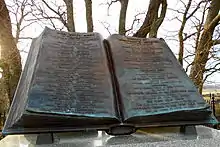High Water Mark of the Rebellion Monument
The High Water Mark of the Rebellion Monument[2] is a Gettysburg Battlefield memorial which identifies the Confederate Army of Northern Virginia units of the infantry attack on the Battle of Gettysburg, third day, with a large bronze tablet, as well as the Union Army of the Potomac's "respective troops who met or assisted to repulse Longstreet's Assault." The memorial is named for the line of dead and wounded of Pickett's Charge which marked the deepest penetration into the Union line at The Angle when "4,500 men threw down their arms and came in as prisoners".[3] The line is now generally marked with unit monuments which are also historic district contributing structures. The High Water Mark monument is accessible via Hancock Avenue which has parking spaces alongside, and a path leads to the site from a parking lot at the former Cyclorama Building at Gettysburg, which served for fifty years as a Gettysburg Battlefield visitor center by the National Park Service until it was demolished in 2013.[4]
 The front tablet on the High Water Mark of the Rebellion Monument is on a pedestal (bottom) in front of the Copse of Trees | |
 Location in Pennsylvania | |
| Coordinates | 39°48.747′N 77°14.143′W |
|---|---|
| Location | Gettysburg National Military Park, Pennsylvania[1] |
| Designer | John B. Bachelder |
| Dedicated date | 1892 |
History
The monument's designer identified the turning point of Pickett's Charge, as "unquestionably the "high water mark of this battle, and of the war!" "[3] After Bachelder's monument proposal was denied by the Gettysburg Battlefield Memorial Association two years in a row, it was approved in the third year.[5] Erected by April 27, 1892, the monument was recast to add two missing units[6] and then dedicated with a speech by then-former Governor Beaver advocating the battlefield become a National Park.[7] The Marine Corps Band provided music, short addresses were made by Union Generals Schofield, Slocum, Webb, Veazey, and others, and Samuel M. Swope presented the monument to John M. Vanderslice of the Gettysburg Battlefield Memorial Association.[7]
An 1895 tablet (MN389) was added to the memorial to identify the Gettysburg Battlefield Memorial Association directors,[2] and the memorial was the site of an 1897 lecture by James T. Long to 7,097 excursionists at The Angle.[8]
| Wikimedia Commons has media related to High Water Mark of the Rebellion Monument. |
References
- "High Water Mark" (HMdb.org webpage, marker 16160). Archived from the original on July 26, 2011. Retrieved February 11, 2011.
Located in front of the "Copse of Trees" on Cemetery Ridge in Gettysburg National Military Park.
- Bachelder, John B (1892), High Water Mark of the Rebellion Monument, Gettysburg Battlefield Memorial Association, archived from the original (NPS.gov webpage about monument) on July 21, 2011, retrieved February 11, 2011,
rear tablet added 1895 (MN389) listing directors of Gettysburg Battlefield Memorial Association. All 9'H.
- Bachelder, John Badger (1873). Gettysburg. What to see How to see it (Google books). Archived from the original on July 9, 2014. Retrieved January 17, 2011. (also available at HathiTrust.org) Archived May 4, 2019, at the Wayback Machine
- Worden, Amy (March 11, 2013). "Gettysburg's Cyclorama building is no more". The Philadelphia Inquirer. Archived from the original on May 9, 2020. Retrieved July 7, 2020.
- Krauth, Jno. M. (June 16, 1886). "Board meeting minutes" (1982 transcription). Minute Book, Gettysburg Battlefield Memorial Association, 1872–1895. Gettysburg Battlefield Memorial Association. Archived from the original on March 7, 2012. Retrieved November 2, 2011.
- "Battlefield Notes" (Google News Archive). The Star and Sentinel. April 27, 1892. Archived from the original on April 7, 2017. Retrieved June 28, 2011.
The front tablet of the "High-water" marker is to be taken down and re-cast, with larger and more distinct lettering. The names of two batteries are to be added : Edgell's New Hampshire and Hill's West Virginia. This will remedy the one defect of the Marker. The change will be made prior to the dedication on June 2.
:3 - "High Water Mark Monument unveiled" (PDF). The New York Times. June 3, 1892.
- Weeks, Jim (2003). Gettysburg: Memory, Market, and an American Shrine (Google Books). p. 92. Retrieved March 14, 2011.